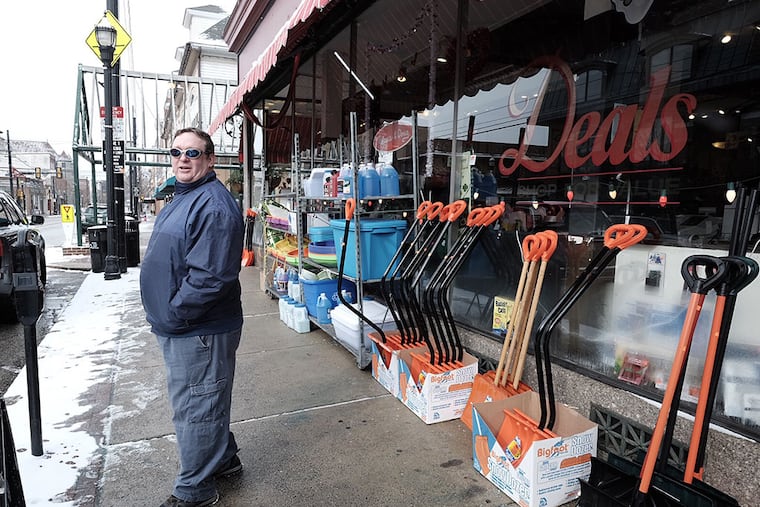'Flakegate' and the incredible shrinking snow totals
Meteorologically, the forecasts didn't miss by much. Just enough to affect the lives of tens of millions of people in one of the nation's densest population corridors.

Meteorologically, the forecasts didn't miss by much. Just enough to affect the lives of tens of millions of people in one of the nation's densest population corridors.
How a forecast of one to two feet of snow for the Philadelphia region shrank into an actual snowfall of one to two inches will be the subject of intensive reviews, government officials promised Tuesday.
But in essence, the forecast computer models got into a 48-hour food fight, and generally the weather forecasters sided with the most trusted one, operated by the European Union. Evidently, that was a mistake.
The storm veered farther east than expected - perhaps 30 to 60 miles - sparing Philadelphia and New York City of the worst, but not before hundreds of flights had been canceled, schools had been closed, the governors of New Jersey and Pennsylvania had declared states of emergency, and the mayor of New York City had stopped just short of telling the citizens of Gotham to run for the hills.
The miss, dubbed by a New York reporter "the Fizzard of 2015," generated a flurry of apologies by meteorologists, including a well-publicized tweet by Gary Szatkowski, meteorologist in charge of the National Weather Service office in Mount Holly, in which he offered his "deepest apologies" for the forecast.
One who wasn't apologetic, however, was Szatkowski's boss, Louis I. Uccellini, the weather service director.
"I understand Gary's disappointment," Uccellini said at a media briefing at weather service headquarters outside Washington.
But Uccellini defended the weather service's performance, and "given the uncertainties and the tens of million of people affected, this was the right forecast to make."
Meteorologists are likely to get more cracks at this in the next several days, with at least two more threats on the horizon.
As for the one that bypassed Philadelphia and ended up punishing New England, "no one here is feeling happy about the forecast," Szatkowski said.
In the end, the official total at Philadelphia International Airport/National Park of 1.2 inches even failed to topple the reigning titleholder for the biggest snow of the winter - Jan. 6, when 1.5 inches was measured. New York received more than a half-foot, but not the two-foot blizzard that was expected.
Ironically, the weather service forecast posted Saturday afternoon for Monday and Tuesday in Philadelphia was way more accurate than the updates.
But by late Saturday, a model run by the European forecast center had latched onto the idea of a monster East Coast storm, predicting that a clipper would redevelop off the coast and bury Philadelphia under two feet of snow or more, said Tony Gigi, a lead forecaster at the Mount Holly office.
Philadelphia and New York would be near the western boundary of the cutoff line for heavy snow, as is often the case with nor'easters.
Models run by the recently upgraded Global Forecast System (GFS), run by the United States, saw the storm heading out to sea. The Europeans held onto the blockbuster idea for Philadelphia and New York in subsequent runs Sunday, and it gained some support from the shorter-range U.S. North American Model runs.
In the end, the GFS had the better handle on what unfolded.
"It was a win for the American model," said Bill Deger, meteorologist with AccuWeather Inc., which had expected six to 12 inches in Philadelphia.
Taking into account the uncertainty of the extent of the snow shield - the area covered by snow - the Weather Channel predicted just three to five inches for the region, said its winter specialist Tom Niziol, a Buffalo, N.Y., native and 30-year veteran of the weather service. He said the Weather Channel opted for a compromise among the various model solutions.
At a prewinter briefing, meteorologists at the Mount Holly office noted that they were now consulting 57 different models.
"It's called chaos," said Chet Henricksen, Szatkowski's predecessor, now retired. "You look at all these models. . . . It's not like going to the table and betting black or red."
By late Monday, snow totals were nowhere near what had been expected. But at 10 p.m., the weather service continued to call for eight to 10 inches in the city.
"I think there comes a time when you have to decide when a forecast is going bad," he said. "We simply weren't there yet."
He said that at the time, snow bands were trying to drive westward across New Jersey. But a few hours later, the weather service finally trimmed the amounts.
One person who was glad the forecasters opted for caution was Mayor Nutter, defending his decision to shut down the city.
"I'd rather be wrong and virtually nothing happens," he said, "as opposed to wrong and 14 inches of snow shows up, and we're not ready for it."
SNOWFALL IN INCHES
35
Auburn, Mass.
24
Montauk,
Long Island
23
Boston
9.8
New York City
4.6
Lower Makefield, Bucks County
3.3
King of Prussia
2
Moorestown
1.2
Philadelphia International AirportEndText
610-313-8210
@woodt15